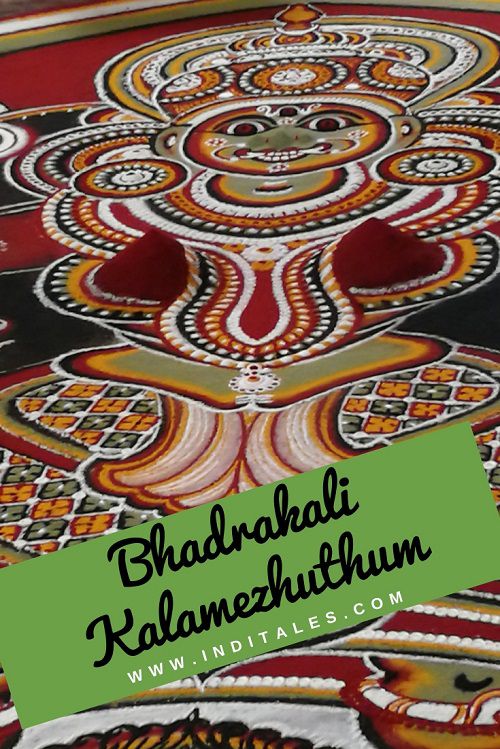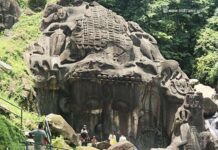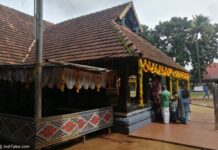Kalamezhuthum Pattum was a surprise discovery in Kerala, where I was to attend a seminar on Devi Worship in India. I never knew that the worship of Devi, especially in her form of Bhadrakali is so popular in Kerala. Through some of the papers presented, I gathered a bit about Devi worship in Kerala. Nothing and I repeat nothing, could have prepared me for the sensory extravaganza that was unfolding in the temple outside the Seminar room.

We were told that a Kolam or a Rangoli would be drawn and worshipped. I expected it to be a lovely one in geometric shapes or a mandala. Come with me to get a glimpse of what I saw at Amritapuri.
Kalamezhuthum Pattum – The Temple Ritual
11 AM – Everything begins with a Pooja
The ritual started with a small Pooja. A mandapa was created using four poles and the roof (called Koora) was a white cloth. In the middle was a moon-shaped sword – a kind of a cross between a sword and a sickle, resting against a wooden stool. This is Chandrahasa – the sword of Bhadrakali. There are grains – the symbol of prosperity all around it. Grains, in turn, are surrounded by oil lamps.

The ceremonial ritual starts with the blowing of a conch as the Yajamana or the person sponsoring the ritual offers a red cloth to the priest. The cloth is put on the ceiling and the pooja begins with singing with the live music.
We spend half an hour observing the Pooja before returning to the seminar hall.
2 PM – Kolam of Bhadrakali
We broke for lunch and I stepped into the temple to see how the Kollam or Rangoli is progressing. I was stunned by what I saw. A huge outline defines the Devi with 8 arms. Each hand has a defining Ayudh or weapon in hand. Roughly half of her body was colored and the other half was in waiting.

This is when I learned about the 5 colors used in the making of Kalamezguttu – Red, Yellow, Black, Green, and White. All colors are made from natural sources – that used to be a normal thing in India before chemicals invaded us. White is made from rice flour, black from charcoal, yellow from turmeric, and green from green leaves. Red is either made by mixing turmeric with lime.
We observed the skillful fingers of four men in Vestis moving and creating patterns. The most interesting bit was how the jewelry was being created by making the color pass through the gaps between fingers. It was magical. While I was trying to figure out how they color, Ma Bhadrakali was already adorned with her jewelry.

The designs of Bhadrakali Kolam I was told are made impromptu. The form and icons are fixed. The costume and jewelry are painted in a different way every time – allowing the artisans freedom within the defined boundaries.
5 PM – Bhadrakali Kolam is ready to be worshipped
The mural is almost complete or so it looks to us. It was breathtakingly beautiful in vibrant colors complete with a Raudra or a fearsome expression on the face of Ma Bhadrakali. Just look at the way the necklaces sit on top of her breasts giving a three-dimensional look to the mural.

However, it is when we come back after another hour or so that we realize that the most difficult part of the mural has been added. It was the head of Daruka or the demon killed by the goddess Bhadrakali. The depiction of the Daruka was so real, it felt as if the head has just been severed.
We were introduced to musical instruments like Ilathalam, Veekkan Chenda, Kuzhal, Kombul, and Chenda.
7 PM – Worship of Bhadrakali
The Goddess is ready in all her glory. Her body is outlined beautifully as she holds a serpent or a naga in one hand and the head of Daruka in another. She is surrounded by mounds of grains on banana leaves with coconuts on top of them. Oil lamps interspersed the grain mounds at regular intervals. A priest sits near her feet and starts the worship. He invokes the Devi, and worships her, as three people play music and sing the Devi Stutis.
Chanrahasa – the sword rests towards the head end of Bhadrakali Devi on the same wooden stool. Behind it is a Kerala metal mirror decorated with a bright fan around it.
After the Pooja was complete, drums start playing.
9 PM – Time to send her back
The scene moves outside the room. One of the persons involved in the ritual was possessed and became an Oracle. He danced and we saw him as the Devi incarnate. We welcomed the Devi with traditional Aarti Thali or the plate with oil lamps & flowers. Since I was wearing a Sari that day, I became a part of the ritual of welcoming the Devi.
He stopped at places, picked up grains and flowers from our plates, and blessed all those around.

The tempo of the drums and the dance increased as we moved back into the room. Inside the room, the man who was now Devi danced around the image for good 30-40 minutes. All this while the sword in which the Devi was invoked was in his hands. His hands trembled but his grip remained tight. Toward the end, he rotated the sword like a performer as he circumambulated around the image of Bhadrakali. Some people felt scared but most of us were in awe of what we were witnessing.
At some point in time, the chief priest erased the face of the Devi drawn on the floor. The Oracle then stepped on the drawing and danced. He slowly erased the rest of the drawing with his feet or with leaves available there. The powder was then given as a prasad to all those present there.
Speechless we all were – soaking in the visual spectacle that we just witnessed amidst the high-energy crescendo created by the drums. I felt a tinge of sadness as I saw the beautiful painting return to its powder state with all the colors mixed together.
Video of Kalamezhuthum Pattum
I was able to capture a small video that details all the rituals for you. Go ahead watch and enjoy it.
The next day we asked the local experts to explain to us this ritual of Kerala from various angles. Here is all that I gathered for you.
What is Kalamezhuthum Pattum?
Kalamezhuthum comes from two words Kalam & Ezhuthu in Malayalam. Kalam means picture and Ezhuthu means painting. So, the word essentially means painting a picture. However, the picture is just one part of the whole ritual. Singing, dancing, and playing music have an equally important role in the ritual. Songs sung are in old Malayalam, which is a mix of current-day Tamil and Malayalam.
In the initial part of the ritual, songs are sung to invoke the Devi in the image. Toward the end of the ritual, songs are sung to pacify the Goddess.
It is also a harvest ritual where the peasants request the goddess to protect their crops.
It brings together different communities who play different roles in the rituals. The main pooja is done by a Brahmin. The Kurup community plays the music, Polluvars play the drums, and the Warriors collect the flowers to make garlands. Basically, all communities have a role to play in the ritual.
Kalamezhuttu is on the intangible heritage list of UNESCO.
Philosophically, Kalamezhuthum Pattum depicts the three states of existence in the world – Srishti or Creation, Sthiti or sustenance, and Samhar or destruction.
Story of Darukasura
Asura Daruka did severe penance and received a boon from Shiva. Daruka asked that no man can kill him, thus asking for immortality in his mind. Shiva granted the boon. Now, aware of his immortality he started creating havoc. This Shiva created Kali from his third eye and it is she who killed the Asura Daruka.
It is said that when Narada Muni was narrating this story to Shiva, he drew a picture thus starting this tradition of drawing the image of Kali as Darukajit or the one who won over Daruka.
When is Kalamezhuthum Pattum Ritual done?
It can be done at any time of the year. Many people do it to ask the Goddess for a wish. People typically do it for getting rid of diseases, to get a job, or to get married.
However, annually it is done in the month of Kartik that would typically falls in October/November. In the Bhadrakali temples of Kerala, it is done every day from the first day of Kartik month for 41 days.
It is an evening ritual. The picture is drawn throughout the day. Depending on the complexity and size they may begin the process either in the morning or afternoon. The main ritual always takes place in the evening.
Where is the Kalamezhuthum Pattum ritual performed?
It is traditionally performed in Kali temples or Bhagwati Temples. It is particularly popular in Bhadrakalii temples of Kerala. In some versions, it is also performed in Ayyapa temples & Vettakkorumakan (son of Shiva and Parvati as hunters) temples where the painting would correspond to the temple deity.
There is no restriction on where it can be performed as long as it is a sacred space and that can be your temple at home.
I would highly recommend watching this temple ritual of Kerala. You have to see it, to believe it – both how beautiful it looks when so many kinds of art forms come together and the sheer energy it creates.
Read more on Devi Temples
Ancient Shakti or Devi Temples in Haridwar to visit
50 Indian Cities named after Devi or Goddess















is it the version of devi bhava darshan held in the mornongs and evenings in the amritanandamayee ashram ? although i have been to the ashram a couple of times cud not witness the same
Dr. Karthik, this is not a regular ritual that happens at Amritapuri. This is done in Bhadrakali temples as I have mentioned in the post above.
Kalamezhuthu pattu performed mostly in Bhadrakali temples are known as Bhadrakali kalam and Pattu. These are also sung in Vettakkorumakan temples. The number of hands of Bhadrakali determines the size of the kalam. Some kalam have sixteen to sixty-four hands. Am planning to take a tour to India for a while.
Thanks, Matt, for adding more information on Kalamezhuthum.
Beautifully detailed! I’ll never forget the first pooja I witnessed in a Hindu temple in Jaffna, Sri Lanka. It was incredible but so overwhelming to an outsider who didn’t know the meaning behind everything that was going on. Thanks for explaining everything so well.
Leslie, being an Indian I am used to various types of Poojas, but this one left me in complete awe. Kalamezhuthum was so elaborate and intense.
Namsthey,
Can you please give contact detail of the people who is doing this…because we have this Poona every year in our temple…but now the people usually doing the Poona , they are not available …we don’t have another people..please help..you can mail me on sreejiththampi@gmail.com..please..
Sreejith – I do not have the contacts, but I hope someone will see this and respond to you.